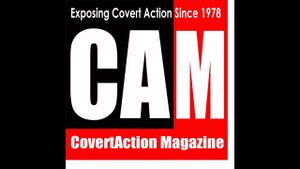Difference between revisions of "CovertAction Quarterly"
m |
(website) |
||
| Line 8: | Line 8: | ||
|namebase=http://www.namebase.net/names/nn01.cgi/CK | |namebase=http://www.namebase.net/names/nn01.cgi/CK | ||
|type=magazine | |type=magazine | ||
| + | |website=https://covertactionmagazine.com/ | ||
|interests=CIA, Covert operations | |interests=CIA, Covert operations | ||
|founders=Philip Agee, William H. Schaap, Ellen Ray | |founders=Philip Agee, William H. Schaap, Ellen Ray | ||
Latest revision as of 04:42, 15 November 2024
 | |
| Type | magazine |
| Founder(s) | Philip Agee, William H. Schaap, Ellen Ray |
| Founded | 1978 |
| Author(s) | various |
| Interests | CIA, Covert operations |
| A magazine focused on US covert operations, relaunched in 2018. | |
CovertAction Quarterly now CovertAction Magazine is a publication focused on the CIA like its 'precursor' magazine CounterSpy. It started as CovertAction Information Bulletin in 1978, was later renamed CovertAction Quarterly and published till 2005. It relaunched in 2018 as CovertAction Magazine.
Contents
Legal change
Its 'Naming names' column inspired the 1982 Intelligence Identities Protection Act which made it a crime to name US spooks.
Reporting
In 1998, the magazine won an award from Project Censored for a story by Lawrence Soley in the Spring 1997 issue titled "Phi Beta Capitalism", about corporate influence on universities.[1] Another article highlighted by Project Censored was Michel Chossudovsky's 2000 claim that the World Trade Organization was an "illegal institution".[2]
End of CovertAction Quarterly
In 1998 the publishers of CovertAction Quarterly decided to fire the staff which was on a day to day basis involved with the production and publication of the magazine.[3][4] After that it was published only a few more years and with less frequency.
FOIA
MuckRock asked about the magazine in 2016.[5]
Anthologies
Several articles from CovertAction Quarterly were collected in two anthologies, Covert Action: The Roots of Terrorism (ISBN 978-1876175849) and Bioterror: Manufacturing Wars The American Way (ISBN 978-1876175641), both published in 2003.
CovertAction Magazine
The project was relaunched in 2018 as CovertAction Magazine (CAM).[6] Old issues have been made available as well.
Afghanistan
On 10 August 2021, CAM published an article entitled "Afghan Tragedy: Still Relevant Today As it Was Analyzed 15 Years Ago":
Canadian academic Dr John Ryan first published this article in Global Research in July of 2006, just before the fifth anniversary of the Afghan War. Originally titled “Afghanistan: A Tale of Never-Ending Tragedy,” this article — with a new introduction by Steve Brown — retains its relevance 15 years later as media pundits try to forestall the US departure from Afghanistan, the site of America’s longest war.—Editors
Introduction
By every measure, the Afghan War has been a failure for America. But it has been a $5 trillion success for American corporations like Lockheed Martin, DynCorp, General Dynamics, Black & Veatch, Halliburton and the oil companies which shipped half-a-million gallons of fuel a day for our army to run on, as well as the military contractors (including suppliers of mercenaries such as Blackwater), whose workers outnumbered soldiers in Afghanistan by three to one.
The Afghan War was a great boon to arms manufacturers like General Dynamics which manufactured these Hydra rockets that were used by the US army in the fight against the Taliban.
Before the US invasion, Taliban leader Mullah Mohammed Omar had been working diligently with the UN to wipe out heroin production in his country. (He thought it was “un-Islamic.”) And he actually did wipe it out. In what must surely be the world’s most successful “War on Drugs,” he reduced poppy farming and opium production by an astonishing 99% in less than 13 months.
Unfortunately for the world, after the US invaded Afghanistan in 2001 and overthrew the Taliban, a succession of corrupt puppet governments installed by the US proceeded to resuscitate and supercharge the profitable production of opium to such an extent that Afghanistan now provides 90% of the entire global opium supply (which then gets distributed by the Kosovo Albanians, another “narco-state” created and controlled by the US).
This is among the key legacies that US troops will leave behind as they depart — though as CAM has previously reported, the war will actually go on via proxy as the US plans to continue bombing Afghanistan from outside air bases, while pouring in billions of dollars annually to fund the Afghan army.[8]
Documents sourced from CovertAction Quarterly
| Title | Type | Subject(s) | Publication date | Author(s) | Description |
|---|---|---|---|---|---|
| Document:George Bush and the CIA In the Company of Friends | article | CIA George H. W. Bush US/Deep state Zapata Petroleum | 1992 | Anthony Kimery | An overview of Bush's CIA work and related business activity. |
| Document:The Long Secret Alliance | article | Cambodia Khmer Rouge Pol Pot | September 1997 | John Pilger | The suppressed history of US sponsorship of the genocidal Pol Pot Khymer Rouge regime in Cambodia through the 1970-80's |
References
- ↑ http://www.projectcensored.org/top-stories/articles/3-big-business-seeks-to-control-and-influence-us-universities
- ↑ Project Censored, Top 25 Censored Stories of 2001: 13. The World Trade Organization is an Illegal Institution
- ↑ https://fas.org/irp/news/1998/07/980713-caq2.htm
- ↑ https://cryptome.org/jya/caq-purge.htm
- ↑ https://www.muckrock.com/foi/united-states-of-america-10/covertaction-quarterly-24737/
- ↑ https://covertactionmagazine.com/archives/
- ↑ "Biden Betrays Another Campaign Pledge—Admits that U.S. Will Continue to Bomb Afghanistan"
- ↑ "Afghan Tragedy: Still Relevant Today As it Was Analyzed 15 Years Ago"
